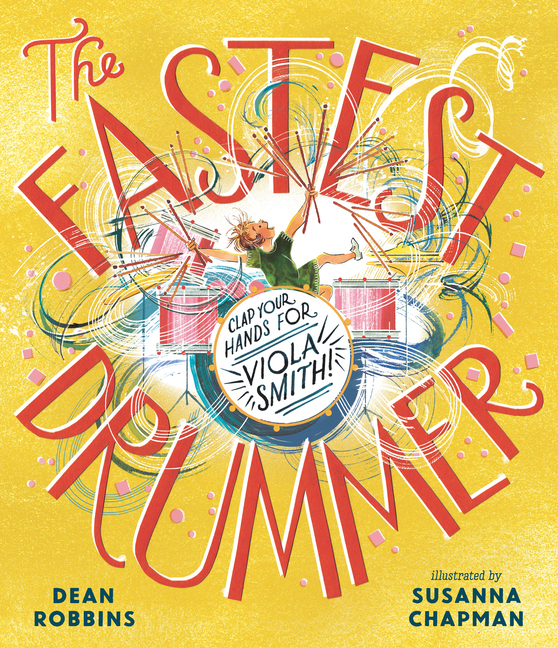Book Descriptions
for The Fastest Drummer by Dean Robbins and Susanna Chapman
From Cooperative Children's Book Center (CCBC)
When Viola Smith first played the drums, “She lost the beat, made a terrible racket, and had more fun that she’d ever had before!” Born in 1912, Viola grew up in Mount Calvary, Wisconsin, where she and her sisters had a family band, the Smith Sisters Orchestra. They performed in town and around the Midwest, and Viola never passed up an opportunity to talk with other drummers about how she could improve. Most of her sisters lost interest in the band as they got older, but not Viola, who also knew women didn’t get as much respect or as many opportunities as men in the music business. To try to change that, she formed her own women’s band, The Coquettes, in the 1930s. During World War II, she advocated for women musicians to fill in for male musicians who were serving in the war. Spirited, curious, skilled, and dynamic, Viola performed with other renowned drummers and musicians throughout her career (she was sometimes called “the fastest drummer in the world” when she was younger; and was still playing at age 100). A vivacious picture book biography capturing Viola’s enthusiasm, drive, and force of personality is paired with mixed-media illustrations full of energy and movement. An author’s note telling more about Viola, glossary of musical terms, and sources are included.
CCBC Choices 2025. © Cooperative Children's Book Center, Univ. of Wisconsin – Madison, 2025. Used with permission.
From the Publisher
Clap your hands for Viola Smith--the pioneering female drummer at the heart of this bright and rhythmic biography, who rat-tat-tat-bang-crash-clink-boomed for nearly a century.
Five girls played together in the Smith Sisters Orchestra: Irene on trombone, Erma on vibraphone, Edwina on trumpet, Mildred on violin, and Lila on saxophone. But what of the littlest sister? When Viola's time came, almost every instrument was taken . . . except one. When she first sat behind a drum kit, she lost the beat, made a terrible racket, and had more fun than she'd ever had before. Viola took to the road with her family, learned from the greats, formed her own band in the face of discrimination and ridicule, mastered twelve- and seventeen-piece drum kits, and played so fast she left no room for doubt: women could not only keep the beat--they could beat the odds. At one hundred years of age, Viola was still slamming her snare and socking her cymbals. Dean Robbins's affectionate portrait of one of the few female professional drummers of the early twentieth century includes an endnote with resources for discovering other female musicians. Susanna Chapman's swirling illustrations capture the joy and energy of Viola's stage presence while introducing young readers to the essential art form of jazz.
Five girls played together in the Smith Sisters Orchestra: Irene on trombone, Erma on vibraphone, Edwina on trumpet, Mildred on violin, and Lila on saxophone. But what of the littlest sister? When Viola's time came, almost every instrument was taken . . . except one. When she first sat behind a drum kit, she lost the beat, made a terrible racket, and had more fun than she'd ever had before. Viola took to the road with her family, learned from the greats, formed her own band in the face of discrimination and ridicule, mastered twelve- and seventeen-piece drum kits, and played so fast she left no room for doubt: women could not only keep the beat--they could beat the odds. At one hundred years of age, Viola was still slamming her snare and socking her cymbals. Dean Robbins's affectionate portrait of one of the few female professional drummers of the early twentieth century includes an endnote with resources for discovering other female musicians. Susanna Chapman's swirling illustrations capture the joy and energy of Viola's stage presence while introducing young readers to the essential art form of jazz.
Publisher description retrieved from Google Books.


